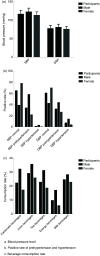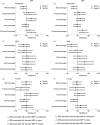Association of consumption of sugar-sweetened beverages with elevated blood pressure among college students in Yunnan Province, China
- PMID: 38418286
- PMCID: PMC10966883
- DOI: 10.1017/S1368980024000569
Association of consumption of sugar-sweetened beverages with elevated blood pressure among college students in Yunnan Province, China
Abstract
Objective: Although some studies have examined the association between eating behaviour and elevated blood pressure (EBP) in adolescents, current data on the association between sugar-sweetened beverages (SSB) and EBP in adolescents in Yunnan Province, China, are lacking.
Setting: Cluster sampling was used to survey freshmen at a college in Kunming, Yunnan Province, from November to December. Data on SSB consumption were collected using an FFQ measuring height, weight and blood pressure. A logistic regression model was used to analyse the association between SSB consumption and EBP, encompassing prehypertension and hypertension with sex-specific analyses.
Participants: The analysis included 4781 college students.
Results: Elevated systolic blood pressure (SBP) and diastolic blood pressure (DBP) were detected in 35·10 % (1678/4781) and 39·34 % (1881/4781) of patients, respectively. After adjusting for confounding variables, tea beverage consumption was associated with elevated SBP (OR = 1·24, 95 % CI: 1·03, 1·49, P = 0·024), and carbonated beverage (OR = 1·23, 95 % CI: 1·04, 1·45, P = 0·019) and milk beverage (OR = 0·81, 95 % CI: 0·69, 0·95, P = 0·010) consumption was associated with elevated DBP in college students. Moreover, fruit beverage (OR = 1·32, 95 % CI: 1·00, 1·75, P = 0·048) and milk beverage consumption (OR = 0·69, 95 % CI: 0·52, 0·93, P = 0·014) was associated with elevated DBP in males.
Conclusion: Our findings indicated that fruit and milk beverage consumption was associated with elevated DBP in males, and no association was observed with EBP in females.
Keywords: Association; College students; Hypertension; Prehypertension; Sugar-sweetened beverages.
Conflict of interest statement
The authors declare that they have no competing interests.
Figures
Similar articles
-
Mediating effect of physical sub-health in the association of sugar-sweetened beverages consumption with depressive symptoms in Chinese college students: A structural equation model.J Affect Disord. 2023 Dec 1;342:157-165. doi: 10.1016/j.jad.2023.09.020. Epub 2023 Sep 18. J Affect Disord. 2023. PMID: 37730148
-
A descriptive study of beverage consumption among an ethnically diverse sample of public school students in Texas.J Am Coll Nutr. 2010 Aug;29(4):387-96. doi: 10.1080/07315724.2010.10719856. J Am Coll Nutr. 2010. PMID: 21041814
-
Sugar-sweetened beverage consumption and age at menarche in a prospective study of US girls.Hum Reprod. 2015 Mar;30(3):675-83. doi: 10.1093/humrep/deu349. Epub 2015 Jan 27. Hum Reprod. 2015. PMID: 25628346 Free PMC article.
-
Sugar-sweetened beverages increases the risk of hypertension among children and adolescence: a systematic review and dose-response meta-analysis.J Transl Med. 2020 Sep 5;18(1):344. doi: 10.1186/s12967-020-02511-9. J Transl Med. 2020. PMID: 32891165 Free PMC article.
-
Sugar intake and risk of hypertension: a systematic review and dose-response meta-analysis of cohort and cross-sectional studies.Crit Rev Food Sci Nutr. 2024 Sep;64(26):9483-9494. doi: 10.1080/10408398.2023.2213330. Epub 2023 May 23. Crit Rev Food Sci Nutr. 2024. PMID: 37218681
Cited by
-
Associations between sugar-sweetened beverage consumption, moderate-to-vigorous-intensity physical activity levels, and depressive symptoms: a cross-sectional study based on Tibetan university students at high altitude in China.Front Nutr. 2025 May 29;12:1582167. doi: 10.3389/fnut.2025.1582167. eCollection 2025. Front Nutr. 2025. PMID: 40510499 Free PMC article.
References
-
- Writing Group of 2018 Chinese Guidelines for the Management of Hypertension (2019) 2018 Chinese guidelines for the management of hypertension. Chin J Cardiovasc Med 24, 24–56.
-
- Ma SJ, Yang L, Zhao M et al. (2020) Changing trends in the levels of blood pressure and prevalence of hypertension among Chinese children and adolescents from 1991 to 2015. Zhonghua Liu Xing Bing Xue Za Zhi 41, 178–183. - PubMed
MeSH terms
Substances
LinkOut - more resources
Full Text Sources
Medical



